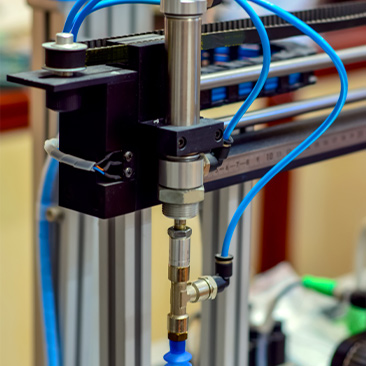Improving Air Flow Efficiency in Pneumatic Systems
Post By: Ryan King On: 05-03-2021 Read Time: 4 minutes - Guides - Pneumatics
Post By: Ryan King On: 05-03-2021 Read Time: 4 minutes - Guides - Pneumatics
When did you last check your pneumatic system to see whether it was operating properly? As with any piece of equipment, you want to be sure it's giving its best performance, which in this case means maximum air flow efficiency and minimum energy wastage. You also need to be able to trust the integrity of the entire system, which means ensuring that all worn or failed parts are immediately replaced.
Keeping your system at its optimum will improve its air flow efficiency and reduce downtime. The best way to do this is to factor preventive maintenance into your schedule, so that you catch faults before they happen. This should also ensure that your pneumatic installation has a longer operational life.

At Rowse Pneumatics, we have a great deal of experience of pneumatic systems, so we'd like to share some of our top tips for improving air flow efficiency.
It's easy to overlook critical components like cylinders and valves, and it amazes us how frequently these parts turn out to be the wrong size. You might think you're making useful economies by choosing a larger capacity cylinder or a smaller valve, for example, but the size of any given component is crucial to the proper running of your whole system.
If you decide to choose components that aren't quite right, the whole system will have to compensate, which typically demands more energy. In the long run, you'll often end paying out on energy costs what you've saved on components.
Having the correctly sized parts will also save you time on replacing worn or broken fittings. If the right sized components have been installed and fit standard clearances, it’ll be much easier to match faulty or defunct parts to their replacements.
The same applies to the operating pressure of your pneumatic system. Older systems in particular are not always designed to be the most energy-efficient, and may be supplying far more pressure than you really need. Operators of pneumatic systems are also prone to thinking that increasing the supply pressure will improve the actuator’s performance. This also wastes energy, and you're far better off installing regulators or pressure sensors if you want to keep your system pressure at the right level.
You should also ensure that the correct distance is gauged from the compressor to the actuator. Provided your load position allows, your conduits and connecting hoses should be not more than ten feet long, and shorter if possible. If the circumstances dictate a greater distance, you'll end up consuming more energy again, as you'll probably require more air pressure to position the load.
There are two possible optimisations that you can employ to reduce unnecessary demand on your air flow. One is to install automatic controls to switch off the supply of compressed air to inactive machinery. These will also reduce the pressure of air supplied to any idling elements, such as air bearings.
The other thing you can do, when using a single-direction cylinder, is to install a spring return actuator, In most pneumatic applications, the actuator is only required to move the load in one direction. The return stroke of the actuator usually demands the same amount of air pressure, but a spring can do this without any air supply at all. This means that the compressor's work is halved, component wear is reduced, and much less energy is consumed.
Tubes and hoses are an essential part of any pneumatic system, but are often ignored in terms of system optimisation. Check all your tubes and hoses straight away to see if any of them are wearing thin or are the wrong size. Regularly check and replace any in this condition to avoid sudden pressure drops if a hose fails without warning. Old-style rubber hoses should also be upgraded for new materials that are more hardy and flexible.
Checking, cleaning and regularly replacing the filters will improve your air flow efficiency instantly, and should be a key element in your preventive maintenance schedule. Filtration units work harder than any other components in a pneumatic system, collecting particulates and dirt which will eventually clog them up. To streamline your system and maximise efficiency, the combination FRL unit is the most effective device for processing the air flow.
You can also cut down the time you spend on maintenance and replacements and greatly improve air flow efficiency by installing flow control fittings. Newer and more efficient automated apps now commonly replace older-style flow controls, and sensors in fully automated systems fine-tune efficiency by constant monitoring of the system's performance.
Leaks are a widespread and common problem that considerably impact air flow efficiency. They can occur at many stages in the system, especially around valves and seals. You should conduct regular inspections and fix any leaks you find right away, before they have a chance to cause serious damage. You might also consider investing in an acoustic measuring device, which will help you to locate even hard-to-see leaks.
Make sure you're using the right valves for your application, and, if appropriate, go for soft seals. Check for seal deterioration, especially if you're working in any kind of extreme environment. Hot, cold, dry or damp environments can all accelerate seal degradation, and a more robust material is advisable in these situations.
Improving air flow efficiency today isn't too difficult, with help available from tools and technological solutions. Energy consumption has higher priority, and you can improve air flow efficiency with preventive maintenance. If your components are the right size, leaks are plugged and new filters regularly installed, you'll soon see an improvement.